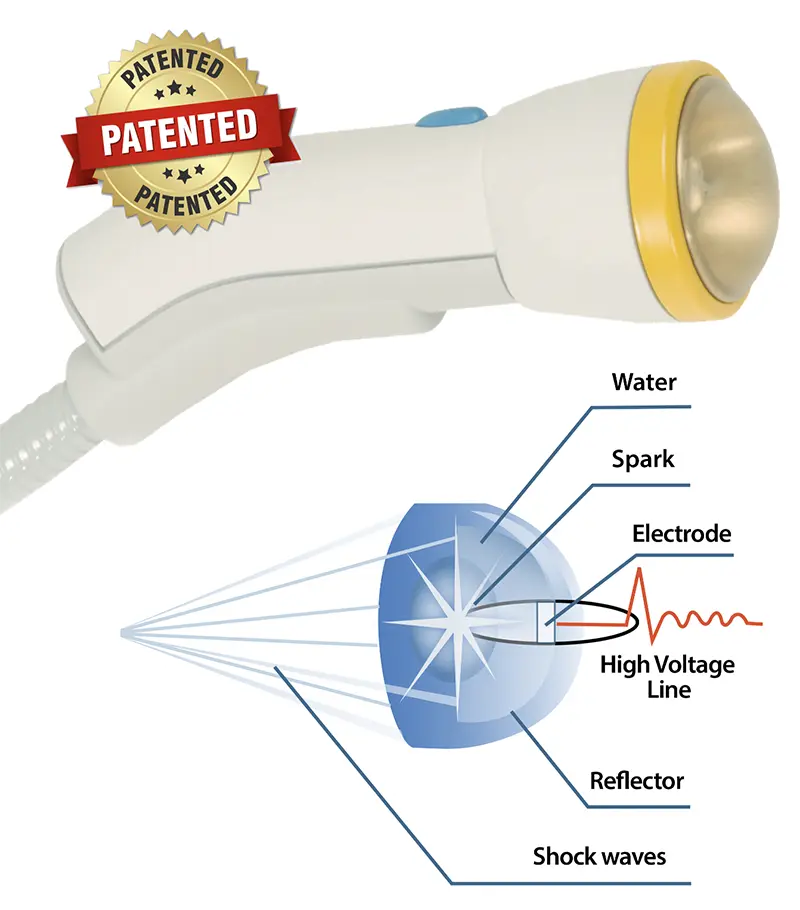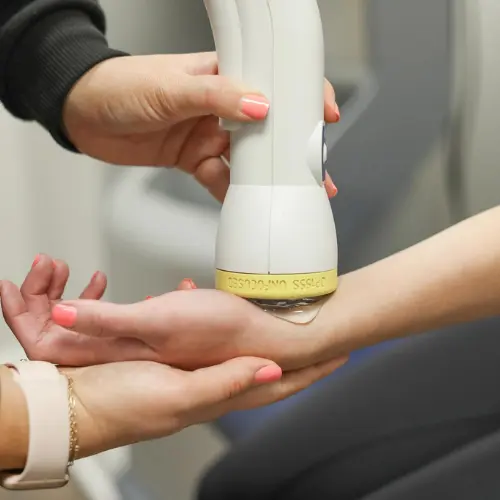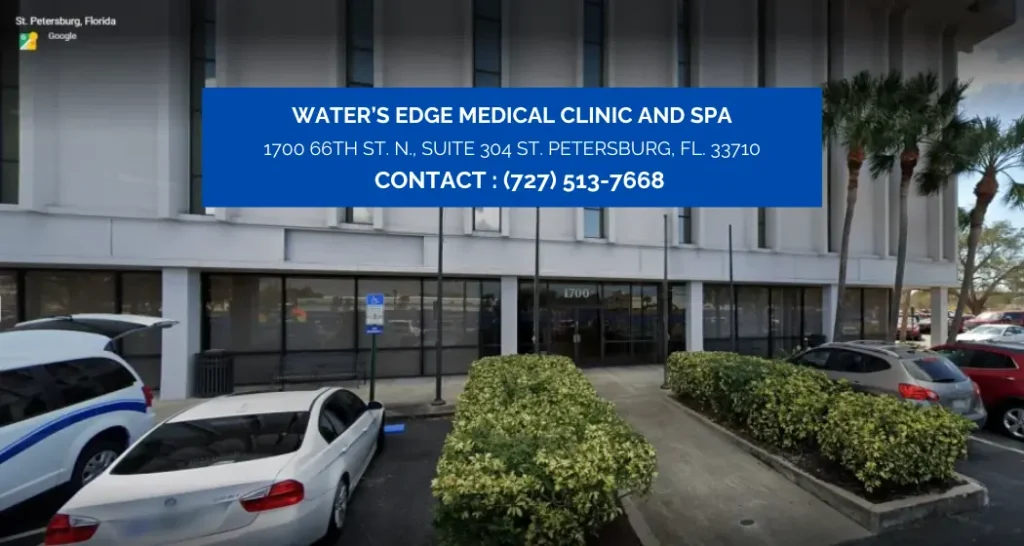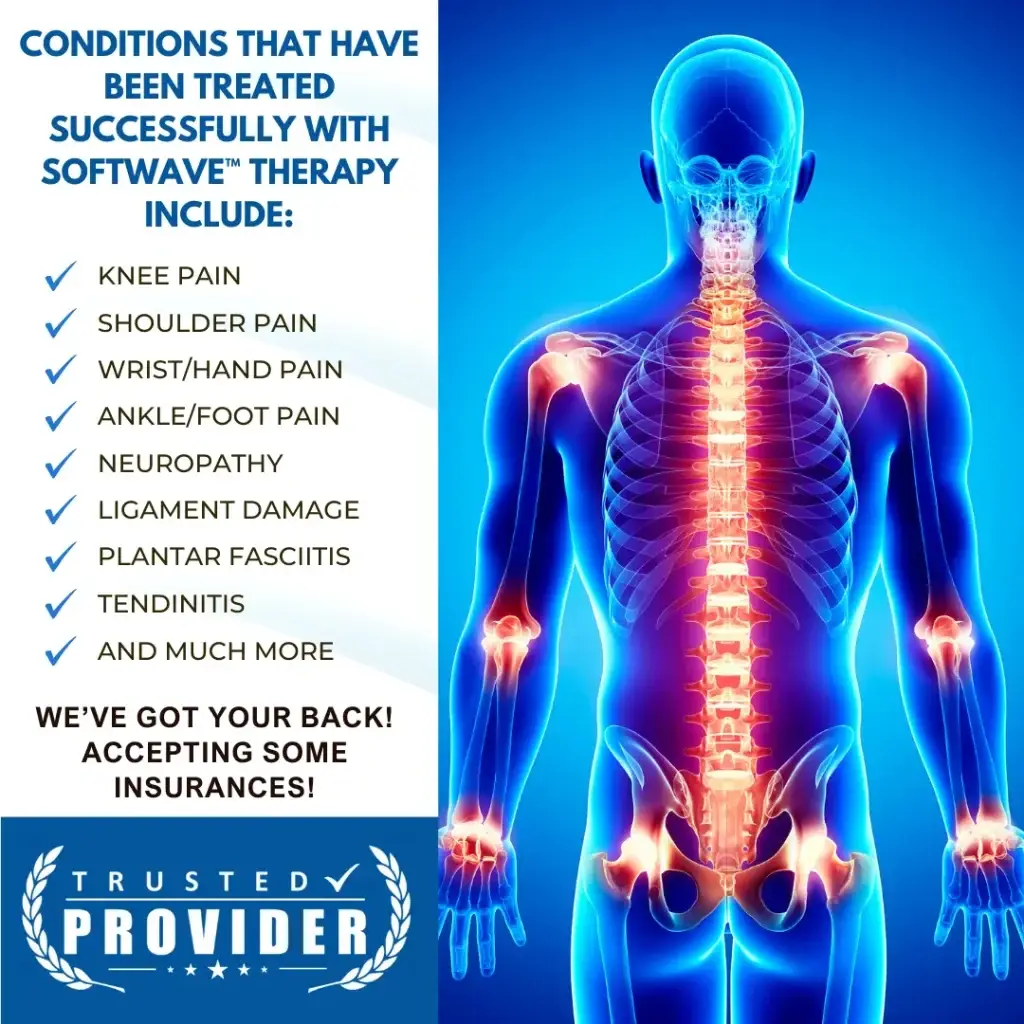Chronic pain is a big problem that many people have, and often causing big problems with how you live your life every day. Fortunately, a revolutionary approach to managing this condition offers newfound hope: Softwave Therapy treatment. Known for its innovative use of high-frequency sound waves, Softwave Therapy treatment provides a non-invasive, drug-free solution to reduce inflammation, alleviate pain, and accelerate the body’s natural healing processes. But what is Softwave Therapy and What does Softwave treatment target?
Key Takeaways
- Softwave Therapy is an innovative, non-invasive treatment that uses shock wave technology to alleviate pain and promote healing.
- It gives you a way to manage pain without using drugs, targeting the root cause of pain without the need for medication or surgery.
- The therapy is suitable for various conditions, including plantar fasciitis, tendinitis, and muscle pain, and is safe for a wide range of patients.
- Patients can anticipate a comfortable experience with low risks and a short recovery time, allowing for a quicker return to daily activities.
- Success stories and testimonials underscore the therapy’s effectiveness in improving quality of life for chronic pain sufferers.
The Fundamentals of Softwave Therapy

Defining Softwave Therapy
What is softwave therapy? Softwave Therapy is an innovative approach to pain management that utilizes low-intensity sound waves to alleviate discomfort and promote healing. This non-invasive treatment targets areas of pain through a handheld device that emits acoustic pressure waves, deeply penetrating the tissues to stimulate blood flow and the body’s natural healing mechanisms.
- Versatile in application, Softwave Therapy can address pain in various body regions and aid in the recovery of pulled muscles and soft tissue injuries.
By enhancing circulation and triggering the release of endorphins, Softwave Therapy not only reduces inflammation but also accelerates the body’s recovery process, making it a compelling alternative to traditional pain management strategies.
To fully grasp the potential of Softwave Therapy, it’s essential to understand its mechanism of action and the conditions it can effectively treat. A series of sessions, tailored to the individual’s needs, is typically recommended for achieving the best results.
The Science Behind the Treatment
Softwave Therapy represents a significant advancement in the realm of pain management, offering a non-invasive solution that taps into the body’s natural healing mechanisms. The treatment utilizes high-frequency sound waves to stimulate cellular repair and regeneration, which can lead to a reduction in pain and inflammation.
The science of Softwave Therapy is grounded in its ability to enhance the body’s innate capacity for healing. This is achieved through a process known as mechanotransduction, where mechanical energy from the sound waves is converted into cellular responses. These responses include increased blood flow, the release of growth factors, and the recruitment of stem cells to the affected area.
- Increased blood flow
- Release of growth factors
- Recruitment of stem cells
By addressing the root causes of pain instead of just the symptoms, Softwave Therapy provides a pathway to long-term relief and recovery. Its compatibility with the body’s natural processes makes it an ideal option for those seeking a holistic approach to pain management.
Comparing Softwave to Traditional Pain Management Methods
Softwave therapy, a non-invasive treatment using high-energy sound waves, stands in contrast to traditional pain management methods. Traditional approaches often rely on medications, which can provide temporary relief but may also lead to side effects and dependency.
- Softwave Therapy: Non-invasive, stimulates healing, reduces pain without drugs.
- Medications: May offer quick relief, potential for side effects, risk of dependency.
- Physiotherapy: Requires consistent sessions, gradual improvement over time.
- Injections: Can be invasive, provides targeted relief, potential for discomfort.
Softwave therapy targets the root cause of pain and promotes the body’s natural healing process, offering a safe and efficient alternative to pharmaceuticals.
When considering pain management options, it’s important to consider both the good and bad parts of each way. Softwave therapy’s ability to alleviate pain without the risks associated with drugs or surgery makes it an attractive option for those seeking a more natural approach to pain relief.
The Mechanism of Action in Softwave Therapy
How Softwave Therapy Targets Pain
Softwave Therapy stands out as a non-invasive and drug-free option for pain management, particularly for chronic conditions. By targeting the root cause of pain, it promotes the body’s innate healing mechanisms, leading to long-term relief and improved function.
- Softwave Therapy is effective for conditions like arthritis, tendonitis, and fibromyalgia.
- It helps healing and lessens swelling, addressing the pain’s origin rather than merely masking symptoms.
The scientific validation of TRT SoftWave’s ability to attract and trigger endogenous cell synthesis enables the body to genuinely begin healing from within.
Understanding the principles behind Softwave therapy can help patients choose their treatment wisely. It gives a natural option instead of drugs or surgery, aiming to make life better for people with long-lasting pain.
The Role of High-Frequency Sound Waves
Softwave Therapy, known as extracorporeal shock wave therapy (ESWT), harnesses the power of high-frequency sound waves to initiate the body’s intrinsic healing mechanisms. These acoustic waves are meticulously directed to the site of pain using a specialized handheld device, which facilitates deep tissue penetration and stimulates cellular repair processes.
- The sound waves encourage blood flow enhancement.
- They promote the release of natural analgesics like endorphins.
- Inflammation is reduced, and tissue regeneration is expedited.
The non-invasive approach of Softwave Therapy allows for a treatment that is devoid of incisions or anesthesia, presenting a compelling alternative to more aggressive pain management strategies.
Patients undergoing Softwave Therapy often report a sensation of mild tingling or pulsation during the session, which is generally not associated with discomfort. This patient-friendly aspect underscores the therapy’s appeal as a pain management solution that does not compromise on comfort.
Understanding the Body’s Healing Process
Softwave Therapy is a cutting-edge treatment that works in harmony with the body’s intrinsic repair mechanisms. By targeting the root cause of pain, it sets the stage for natural healing without the need for invasive procedures or pharmaceuticals. This therapy capitalizes on the body’s ability to regenerate and repair itself, which is a fundamental aspect of our health and well-being.
The process begins with the activation of the body’s stem cells. These cells are crucial for repair and regeneration, and Softwave Therapy stimulates their activity, enhancing the body’s restorative functions. The therapy also promotes increased blood flow and manages inflammation, which are vital steps in the healing process.
- Activation of stem cells
- Enhancement of blood flow
- Management of inflammation
- Acceleration of tissue repair
Softwave Therapy is not just about managing symptoms; it’s about empowering the body to heal itself more effectively and efficiently. It’s a partnership between technology and biology that yields impressive results for those suffering from chronic pain.
Determining Suitability for Softwave Therapy

Assessing Your Candidacy for Treatment
Determining whether Softwave Therapy is the right choice for managing your chronic pain involves a thorough evaluation by a health care professional. Here at Waters Edge Medical clinic we specialize not only with the Softwave, but also with chronic, degenerative issues involving the joints, spine, as well as neuropathy. Our team of specialists will do a physical exam, check your medical history, and talk about your symptoms to see if the treatment is right for you.
To ensure the best outcomes, it’s crucial to follow the personalized treatment plan developed by your healthcare provider. This plan may include a specific number of sessions tailored to your condition.
Patients with certain medical devices, such as cardiac pacemakers or implanted stimulators, may not be eligible for Softwave Therapy. It’s important to disclose all medical information during your consultation to avoid any potential risks.
Conditions Treated by Softwave Therapy
Softwave Therapy has emerged as a versatile treatment modality for a range of conditions, particularly those involving pain and inflammation. Patients often feel much better from chronic pain conditions such as arthritis, tendonitis, and fibromyalgia. This therapy is also beneficial for acute scenarios, including tendon injuries, muscle strains, and the pain associated with musculoskeletal injuries like sprains.
- Arthritis
- Tendonitis
- Fibromyalgia
- Muscle strains
- Tendon injuries
- Plantar fasciitis
- Musculoskeletal sprains
- Erectile dysfunction
- Incontinence
Before beginning treatment, it’s crucial to consult with a healthcare provider to discuss your specific condition and determine if Softwave Therapy is an appropriate option for you.
Softwave Therapy is not a one-size-fits-all solution, but with a personalized treatment plan, many patients begin to see improvements within just a few sessions. Getting a good check-up from a professional who can make the therapy just for you is really important for the best result.
Consulting with Professionals for Softwave Therapy
When considering Softwave Therapy, the first step is to consult with a healthcare professional who is experienced in this innovative treatment. They’ll look at your medical history, check your body, and have a detailed discussion about your symptoms. This comprehensive evaluation really important to find out if Softwave Therapy is the right choice for you.
It’s essential to have a clear understanding of your health condition and the potential benefits of Softwave Therapy before commencing treatment. A professional’s guidance will ensure that the therapy aligns with your specific needs and health objectives.
The number of sessions required for Softwave Therapy can vary based on individual conditions and the severity of symptoms. Here is a general guideline for the frequency of sessions:
- Initial Assessment: 1 session
- Follow-up Sessions: Typically 3-10 sessions
- Maintenance Sessions: As recommended by the healthcare provider
Remember, adherence to the prescribed treatment plan is key to achieving the best outcomes. Your healthcare provider will tailor the number of sessions to optimize your recovery and pain management.
The Softwave Therapy Experience
Preparing for Your First Softwave Session
As you approach your initial Softwave Therapy session, it’s essential to set the right expectations and prepare accordingly. Softwave Therapy is a non-invasive procedure that uses strong sound waves to help healing and lessen long-lasting pain. Upon arrival, a trained healthcare professional will help you through it and answer any questions you have.
Here are some steps to help you prepare:
- Ensure you have consulted with a healthcare provider about your specific condition.
- Understand that the therapy is typically administered in a series of sessions, each lasting 15-30 minutes.
- Familiarize yourself with the potential for improvements within just a few sessions, as part of a personalized treatment plan.
It’s really important to stick to the treatment plan they give you to get the best results possible.
Keep in mind, the number of sessions you’ll need for Softwave Therapy can be very different for each person. Your healthcare professional will tailor the number of sessions to your individual needs and condition.
What to Expect During Treatment
When you arrive for your Softwave Therapy session, you’ll be guided through a process designed to target your pain effectively. Expect a non-invasive procedure that involves the application of high-frequency sound waves to the affected area. These sound waves are generated by a device that utilizes a unique, ground-breaking technique, often resulting in a sensation that can range from mild tingling to a deep, pulsating pressure.
During the session, you’ll remain awake and may be asked to provide feedback to ensure the optimal effectiveness of the treatment. It’s a collaborative process where your input is valuable.
Post-treatment, it’s common to experience some immediate relief, although the full benefits typically unfold over a series of sessions. Your healthcare provider will have developed a personalized treatment plan, which may include a recommended number of sessions based on factors like the severity and duration of your pain, as well as your overall health and response to treatment.
Post-Session: Recovery and Follow-up
After completing a Softwave therapy session, patients are typically able to resume their daily activities with minimal downtime. To get the best result, make sure to follow their instructions carefully. It’s not uncommon for individuals to report immediate pain relief, although the full benefits of the treatment may unfold over the following days to weeks.
- First Few Days After Treatment: Patients should monitor their response to the therapy and note any changes in pain levels or mobility. Mild discomfort or swelling may occur, which is generally manageable with over-the-counter pain relievers.
- Pain Relief: The extent of pain relief can vary from person to person. Some may experience significant improvement right away, while others may notice gradual changes.
During the recovery phase, it’s essential to maintain open communication with your healthcare provider. They can offer guidance on any necessary follow-up sessions and help manage expectations regarding the healing process.
Realizing the Advantages of Softwave Therapy
Non-Invasive Nature and Safety Profile
Softwave Therapy stands out in the field of pain management for its non-invasive nature and commendable safety profile. Unlike surgical interventions, Softwave Therapy does not require incisions, anesthesia, or prolonged recovery periods. This part is especially attractive to patients who are looking for a treatment option that does not involve the risks associated with invasive procedures.
The safety of Softwave Therapy is further underscored by its FDA clearance, which is a testament to its adherence to stringent safety standards. The therapy is drug-free, which eliminates concerns over pharmaceutical side effects or potential dependency issues. Clinical trials have consistently demonstrated a high margin of safety, distinguishing Softwave Therapy from other pain management modalities.
Softwave Therapy’s approach to pain relief is grounded in enhancing the body’s natural healing processes without the need for invasive techniques. This patient-centric treatment allows individuals to manage their pain effectively while minimizing the risk of complications.
The following list highlights some of the key benefits associated with the safety and non-invasive nature of Softwave Therapy:
- Significant pain relief through reduced inflammation and improved blood flow
- Enhanced mobility and joint function
- Lower risk of side effects due to the absence of surgery or medication
Patients have reported positive outcomes, such as returning to activities they enjoy with less discomfort, which speaks volumes about the therapy’s efficacy and safety.
Chronic Pain Relief and Quality of Life Improvement
Softwave Therapy has emerged as a beacon of hope for those suffering from chronic pain, offering a path to not only manage but potentially alleviate their discomfort. The promise of improved quality of life is a compelling reason for many to consider this treatment option. Chronic pain, by its persistent nature, can erode the joy from daily activities and impede one’s ability to participate fully in life.
The benefits of Softwave Therapy extend beyond pain relief:
- Pain Reduction: Patients report a significant decrease in pain levels, which contributes to a more comfortable and active lifestyle.
- Mobility Improvement: Enhanced joint function and flexibility let people do things they couldn’t do before because they hurt or were hard.
- Safe and Non-Invasive: The therapy’s non-invasive approach reduces the risk of side effects, affirming its safety profile.
With consistent treatment, patients often experience a newfound sense of freedom, as they reclaim activities and hobbies that chronic pain had once stolen from them.
While the therapy is promising, it is important to note that outcomes can vary and ongoing research is important to really know how well it works over a long time. As highlighted by a recent NCBI title, larger randomized controlled trials with more objective outcomes are necessary to substantiate the advantages of Softwave Therapy for conditions like low back pain.
Patient Success Stories and Testimonials
The testimonials of patients who have undergone Softwave Therapy are a testament to its effectiveness. Many express profound gratitude for the pain relief and improved mobility they’ve experienced. Here’s a glimpse into the positive feedback from those who have embraced this innovative treatment:
- “They got me back running when no other doctor could, I can’t thank them enough!” Susie
- “Dr. Vida from Waters Edge Medical Clinic gave me a short list of bullet points about what we talked about. It was really helpful.”
- “Dr. Vida from Waters Edge medical clinic was one of the few doctors I’ve dealt with who didn’t blow off my situation and made me feel heard.”
The power of Softwave Therapy extends beyond the clinic, as patients continue to report minimal recovery time, allowing them to strengthen and heal. This is particularly significant for conditions like knee injuries, where Softwave TRT may be a great treatment option.
Patient satisfaction is reflected in the numbers as well, with one clinic boasting a stellar average of 4.9 out of 5 stars from over 19,000 reviews. Such overwhelming positive feedback underscores the transformative impact Softwave Therapy can have on individuals’ lives.
Conclusion
In summary, Softwave Therapy emerges as a groundbreaking and non-invasive approach to pain management, offering a beacon of hope for those burdened by chronic pain. Its utilization of high-frequency sound waves to stimulate the body’s healing mechanisms presents a compelling alternative to traditional treatments, avoiding the risks associated with surgery and the side effects of medication. The therapy’s effectiveness in treating a range of conditions, coupled with its safety profile, underscores its potential as a transformative solution for pain sufferers.
As we have explored throughout this article, Softwave Therapy doesn’t just relieve pain, it also makes life better, making it a worthy consideration for anyone seeking relief from chronic pain. It is a testament to the innovative strides being made in the realm of pain management and a reminder of the ever-evolving nature of medical technology.
Frequently Asked Questions
What is Softwave Therapy?
Softwave Therapy is a treatment that doesn’t involve surgery and uses high-frequency sound waves to stimulate the body’s natural healing processes, reduce inflammation, and alleviate pain without the need for drugs or surgery.
How does Softwave Therapy work?
Softwave Therapy works by directing high-frequency sound waves at the affected area, which promotes increased blood flow, reduces inflammation, and accelerates tissue repair and regeneration, thus targeting the root cause of pain.
What conditions can Softwave Therapy treat?
Softwave Therapy has been effective in treating various conditions such as plantar fasciitis, tendinitis, muscle pain, and other forms of chronic pain.
Is Softwave Therapy safe?
Yes, Softwave Therapy is a safe and non-invasive option for pain management, offering a natural alternative to medications or surgery, with minimal risks and side effects.
What should I expect during a Softwave Therapy session?
During a Softwave Therapy session, you can expect to experience the application of sound waves to the targeted area, which is generally painless. The treatment aims to promote healing and reduce pain, with sessions typically lasting for a short duration.
Who is a candidate for Softwave Therapy?
Candidates for Softwave Therapy include individuals experiencing chronic pain who are seeking a non-pharmaceutical and non-invasive treatment option. It’s recommended to consult with a professional to assess your suitability for the therapy.

If you are interested in trying Softwave therapy for the first time, or have questions. Please feel free to set up a consultation and evaluation for free to discuss your questions or concerns. If you would then like to try a Softwave session, our introductory offer is for $49 if you qualify to receive treatment. You can reach us at 727-550-0855.


